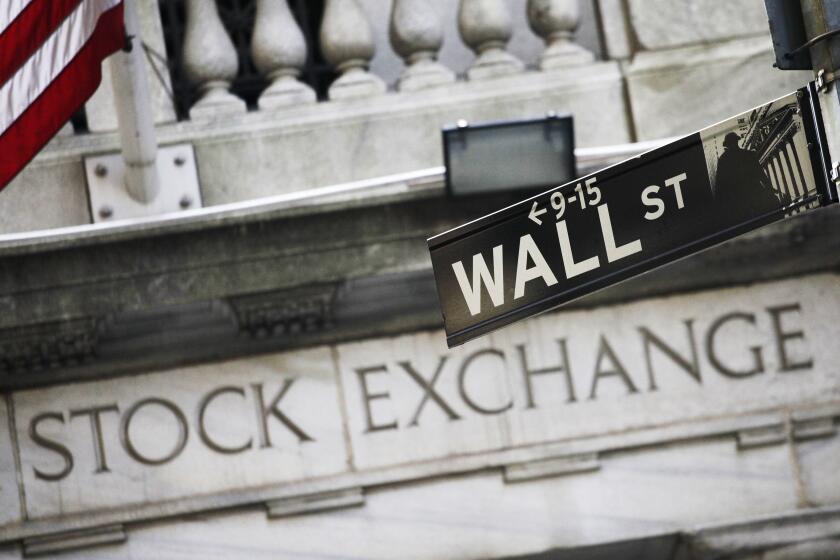Safer in bonds? Yes, to a point
- Share via
Quick -- you have one minute to answer this question: If you had to make a decision today to reallocate money in your 401(k) plan or other investment account, would you sell stocks to buy bonds or sell bonds to buy stocks?
This isn’t just an academic exercise, of course. With the dramatic resurgence of financial markets since March, millions of investors are staring at their portfolios with a mix of joy and apprehension.
People who stayed put in stocks and bonds have recouped a huge chunk of what was lost in the September-to-March crash. Now, for many the goal is to never again face that kind of hell.
For investors who rode out the last year, “the closer they get to recapturing what they lost, the more they begin to talk about reducing risk,” said Rob Francais, a principal at Los Angeles wealth manager Aspiriant, which oversees about $4 billion for clients.
The basic building blocks of any financial portfolio are stocks, bonds and cash accounts. One simple option if you want to play it safer is just to boost your cash holdings.
But with short-term interest rates near zero, cash accounts pay little. That has left some investors searching for a middle ground -- an asset that pays more than cash but also is unlikely to collapse as stocks did when the economy began to fall apart.
Bonds are the logical alternative. They come in different flavors, but their universal attractions are the interest income they pay and their generally lower risk of loss compared with stocks.
I’ve come to realize in writing about bonds for the last few decades that most people grasp the basic concept of fixed-income securities, but they have a much harder time understanding their nuances -- particularly the risks.
Tracking the money that’s pouring into bonds lately, I have a feeling that many investors don’t perceive any risk in those securities at all.
All year, Americans have been shoveling money into bond mutual funds at a heady pace, lifting the funds’ total assets to about $2 trillion. But in the last few weeks that inflow has accelerated.
Bond funds (U.S. government, corporate and municipal) took in a net $12.7 billion in new cash in the week ended Sept. 16, the largest weekly inflow this year, according to the Investment Company Institute trade group. That followed inflows of $8.2 billion in the previous week and $12.1 billion in the week before.
Consider what has been happening with stock mutual funds in the same period: Even as Wall Street continued to rally through mid-September, stock funds overall have been suffering net cash outflows.
Domestic stock funds saw a net $7.1 billion in cash flow out in the three weeks through Sept. 16. That’s the heaviest selling of equity funds since March -- when the stock market was reaching 12-year lows.
Note that we’re talking about small amounts relative to the $3.5 trillion in domestic stock fund assets. But it’s the trend that’s instructive: The public, on balance, has been exiting even as share prices have continued to push higher.
Selling stocks to buy bonds? It sure smells like that’s part of what’s going on.
Usually, investors are prone to chase market rallies. This time, however, many aren’t willing to chase stocks, which are up more than 50% since March as measured by major market indexes.
Wall Street’s big rebound was rooted in the belief that the recession was ending and that the economy would recover. Much of the economic data of the last few months have supported that idea.
Yet fear of another downturn remains rampant, given high unemployment, a still-struggling housing market, consumers’ debt burdens and the fragile banking system.
Those doubts also are driving investors into bonds. If the recovery is suspect, then the two biggest threats to most fixed-rate bonds -- rising market interest rates and rising inflation -- aren’t likely to materialize any time soon.
But the buying wave in the bond market since spring has pushed down yields sharply for investors who are just getting into the market now.
That’s the challenge facing financial advisors who still like the relative safety of bonds compared with stocks. With the drop in yields, “what do you do for an encore?” says Joel Framson, a principal at Silver Oak Wealth Advisors in Los Angeles.
The average annualized yield on an index of 100 corporate junk bonds has plunged to 8.36% now from 13.4% in March. The yield on 10-year California tax-free general obligation bonds has dropped to about 3.6% from 5.25% at the end of June.
Even U.S. Treasury bond yields, which had spiked in spring amid worries about the government’s record borrowing wave, are falling again. The 10-year T-note yield ended this week at 3.33%, down from 3.85% in early August.
Scott Leonard, head of investment advisory firm Trovena in Redondo Beach, says the low current yields on bonds should reinforce with investors that, over the next few years, “the expected returns on equities are far superior to the expected returns on long-term bonds.”
Still, he says, with the rally in stocks over the last six months, the percentage of assets that some investors have in equities may exceed their comfort level. He’s paring back some clients’ holdings and shifting what he sells to a bond fund that focuses on shorter-term securities, maturing in a year or so.
For many investors, the ideal approach to bond investing is to have a mix -- domestic and foreign, government, corporate and muni, longer-term and shorter-term.
But if your knowledge and resources are limited, the key point to understand is this: The longer the maturity of a bond, the greater the potential for it to lose value if either market interest rates rise or inflation heats up.
If you’re just trying to play it safe, stick with mutual funds that limit themselves to shorter-term bonds.
--
More to Read
Inside the business of entertainment
The Wide Shot brings you news, analysis and insights on everything from streaming wars to production — and what it all means for the future.
You may occasionally receive promotional content from the Los Angeles Times.










